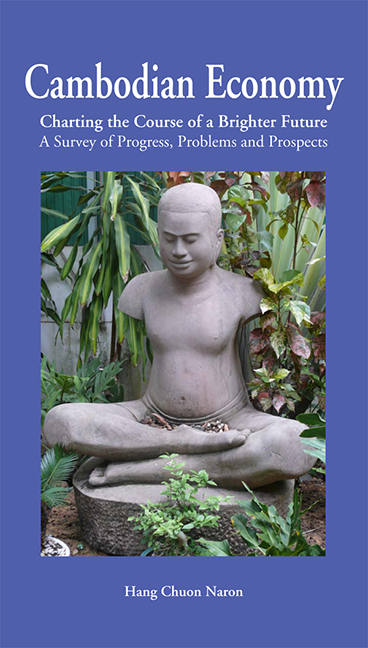 Cambodian Economy
Cambodian Economy Book contents
- Frontmatter
- Contents
- Foreword
- Preface
- INTRODUCTION
- Symbols and abbreviations
- PART I GEOGRAPHY AND POPULATION
- PART II MACROECONOMIC FRAMEWORK
- PART III THE CHALLENGE OF MODERNIZING AGRICULTURE
- PART IV THE CHALLENGE OF INDUSTRIALIZATION
- Chapter 10 Industrial Sector — An Overview
- Chapter 11 Private Sector Development
- Chapter 12 Industrial Policies
- PART V SERVICES AND INFRASTRUCTURE
- PART VI HUMAN RESOURCE DEVELOPMENT
- PART VII PUBLIC FINANCE
- PART VIII INTERNATIONAL ECONOMIC RELATIONS
- PART IX CONCLUSION
- Bibliography
- About the author
Chapter 12 - Industrial Policies
from PART IV - THE CHALLENGE OF INDUSTRIALIZATION
Published online by Cambridge University Press: 21 October 2015
- Frontmatter
- Contents
- Foreword
- Preface
- INTRODUCTION
- Symbols and abbreviations
- PART I GEOGRAPHY AND POPULATION
- PART II MACROECONOMIC FRAMEWORK
- PART III THE CHALLENGE OF MODERNIZING AGRICULTURE
- PART IV THE CHALLENGE OF INDUSTRIALIZATION
- Chapter 10 Industrial Sector — An Overview
- Chapter 11 Private Sector Development
- Chapter 12 Industrial Policies
- PART V SERVICES AND INFRASTRUCTURE
- PART VI HUMAN RESOURCE DEVELOPMENT
- PART VII PUBLIC FINANCE
- PART VIII INTERNATIONAL ECONOMIC RELATIONS
- PART IX CONCLUSION
- Bibliography
- About the author
Summary
Future Challenges and Opportunities
The export oriented garments and textiles sector has been mainly responsible for the high industrial growth of Cambodia in the last decade. Cambodia has been seriously affected by the decline in garment exports due to the global economic slowdown in late 2008. Cambodia has also been losing ground in the US its major destination for garment exports. Cambodia faces several constraints in dealing with the abolition of garments quotas including: (1) declining competitiveness; (2) high concentration on a few markets; and (3) heavy reliance on imported inputs/materials. The current trends in the Cambodian garment industry show a slowdown in market growth, which could cause damage to the industry if measures are not taken to address this backward trend.
Cambodia suffers from poor infrastructure and high cost of utilities. Attention should also be paid to labour costs in Cambodia which have been rising steadily without a matching increase in productivity. Electricity prices, transportation and port handling costs in Cambodia, are high when compared to other countries in Asia. While the still cheap labor cost will be an attraction for foreign investments, this alone will not be sufficient to attract foreign investors as large-scale producers such as India or China also enjoy a similar advantage.
It is crucial that Cambodia maintains its competitive advantage as a low-cost production centre by addressing the high costs of transportation, utilities and handling of containers at the ports. Mechanisms to link wage increases to productivity improvement should also be focused upon. Within the garment industry, expansion of both product range and markets is essential if the industry is to survive and grow. Attention should be given to the further expansion of garment products outside of the quota system.
To reduce transport costs, attention has been given to improve the road network across the country. Large investments have been made in the improvement of national, provincial and rural road infrastructure.
- Type
- Chapter
- Information
- Cambodian EconomyCharting the Course of a Brighter Future - A Survey of Progress, Problems and Prospects, pp. 263 - 278Publisher: ISEAS–Yusof Ishak InstitutePrint publication year: 2012
